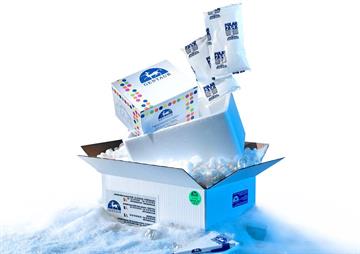Recombinant Human IL-1 beta

Recombinant Human IL-1 beta
1727.75 EUR
In Stock
quantity
Produktdetaljer
Katalognummer: 544 - MBS258305-5x0005mg
Produktkategori: Företag och industri > Vetenskap och laboratorium
MyBiosourceGentaur
Storlek: 5x0.005mg
Parameters
| Storage and shipping | Store at -20 degree C. |
|---|
Related Products
KIF1A-1121H
RecombinantHuman KIF1A Protein, His-tagged
Store at 2-8 centigrade for one month. Aliquot and store at -80 centigrade for 12 months.
617.6 €
400-001
Human IL-1 beta Recombinant Protein
Interleukin-1 beta (IL-1beta) is produced by activated macrophages. IL-1beta stimulates thymocyte proliferation by inducing IL-2 release, B-cell maturation and proliferation, and fibroblast growth factor activity. IL-1beta proteins are involved in the inflammatory response, being identified as endogenous pyrogens, and are reported to stimulate the release of prostaglandin and collagenase from synovial cells. IL-1 is a name that designates two pleiotropic cytokines, IL-1 alpha (IL1F1) and IL1 beta (IL1F2), which are the products of distinct genes. IL- 1 alpha and IL-1 beta are structurally related polypeptides that share approximately 21% amino acid (aa) identity in human. Both proteins are produced by a wide variety of cells in response to inflammatory agents, infections, or microbial endotoxins. While IL-1 alpha and IL-1 beta are regulated independently, they bind to the same receptor and exert identical biological effects. The human IL-1 beta cDNA encodes a 269 aa precursor. A 116 aa propeptide is cleaved intracellularly by the cysteine protease IL-1 beta converting enzyme (Caspase1/ICE) to generate the active cytokine. The mature human IL-1 beta shares 96% aa sequence identity with rhesus and 67% 78% with canine, cotton rat, equine, feline, mouse, porcine, and rat IL-1 beta. Human recombinant IL-1beta produced in E. coli is a non-glycosylated, IL-1 beta polypeptide chain containing 153 amino acids and having a molecular mass of 17.0 kDa.
370.88 €
400-002
Human IL-1 beta Recombinant Protein
Interleukin-1 beta (IL-1beta) is produced by activated macrophages. IL-1beta stimulates thymocyte proliferation by inducing IL-2 release, B-cell maturation and proliferation, and fibroblast growth factor activity. IL-1beta proteins are involved in the inflammatory response, being identified as endogenous pyrogens, and are reported to stimulate the release of prostaglandin and collagenase from synovial cells. IL-1 is a name that designates two pleiotropic cytokines, IL-1 alpha (IL1F1) and IL1 beta (IL1F2), which are the products of distinct genes. IL- 1 alpha and IL-1 beta are structurally related polypeptides that share approximately 21% amino acid (aa) identity in human. Both proteins are produced by a wide variety of cells in response to inflammatory agents, infections, or microbial endotoxins. While IL-1 alpha and IL-1 beta are regulated independently, they bind to the same receptor and exert identical biological effects. The human IL-1 beta cDNA encodes a 269 aa precursor. A 116 aa propeptide is cleaved intracellularly by the cysteine protease IL-1 beta converting enzyme (Caspase1/ICE) to generate the active cytokine. The mature human IL-1 beta shares 96% aa sequence identity with rhesus and 67% 78% with canine, cotton rat, equine, feline, mouse, porcine, and rat IL-1 beta.Human recombinant IL-1beta produced in E. coli is a non-glycosylated, IL-1 beta polypeptide chain containing 153 amino acids and having a molecular mass of 17.0 kDa.
449.62 €
400-002-DC
Human IL-1 beta Recombinant Protein
Interleukin-1 beta (IL-1beta) is produced by activated macrophages. IL-1beta stimulates thymocyte proliferation by inducing IL-2 release, B-cell maturation and proliferation, and fibroblast growth factor activity. IL-1beta proteins are involved in the inflammatory response, being identified as endogenous pyrogens, and are reported to stimulate the release of prostaglandin and collagenase from synovial cells. IL-1 is a name that designates two pleiotropic cytokines, IL-1 alpha (IL1F1) and IL1 beta (IL1F2), which are the products of distinct genes. IL- 1alpha and IL-1 beta are structurally related polypeptides that share approximately 21% amino acid (aa) identity in human. Both proteins are produced by a wide variety of cells in response to inflammatory agents, infections, or microbial endotoxins. While IL-1 alpha and IL-1 beta are regulated independently, they bind to the same receptor and exert identical biological effects.The human IL-1 beta cDNA encodes a 269 aa precursor. A 116 aa propeptide is cleaved intracellularly by the cysteine protease IL-1 beta converting enzyme (Caspase1/ICE) to generate the active cytokine. The mature human IL-1 beta shares 96% aa sequence identity with rhesus and 67% 78% with canine, cotton rat, equine, feline, mouse, porcine, and rat IL-1 beta.Human recombinant IL-1beta produced in E. coli is a non-glycosylated,IL-1 beta polypeptide chain containing 153 amino acids and having a molecular mass of 17.0 kDa.
575.25 €
Håll dig uppdaterad! Visa tidigare publikationer

By: Author , 2 Comment
Anaplasmos hos hundar och katter – allt du behöver veta
23 August 2025

By: Author , 2 Comment
Solbränna – hur leker man säkert i solen?
16 August 2025

By: Author , 2 Comment
Biologiska läkemedel – Modernitet inom farmaci
1 August 2025

By: Author , 2 Comment
Icke-steroida antiinflammatoriska läkemedel – viktig information om populära läkemedel
22 July 2025








